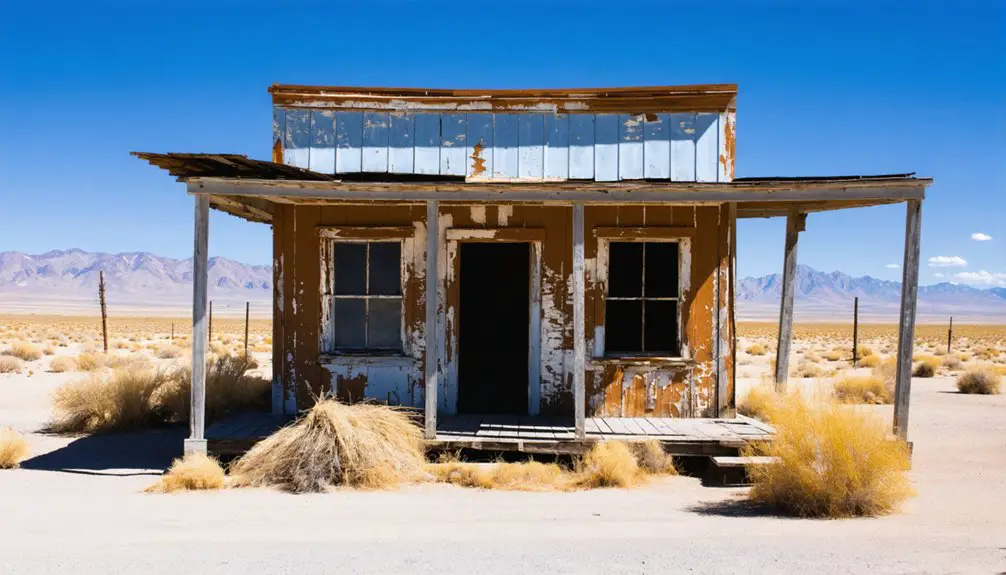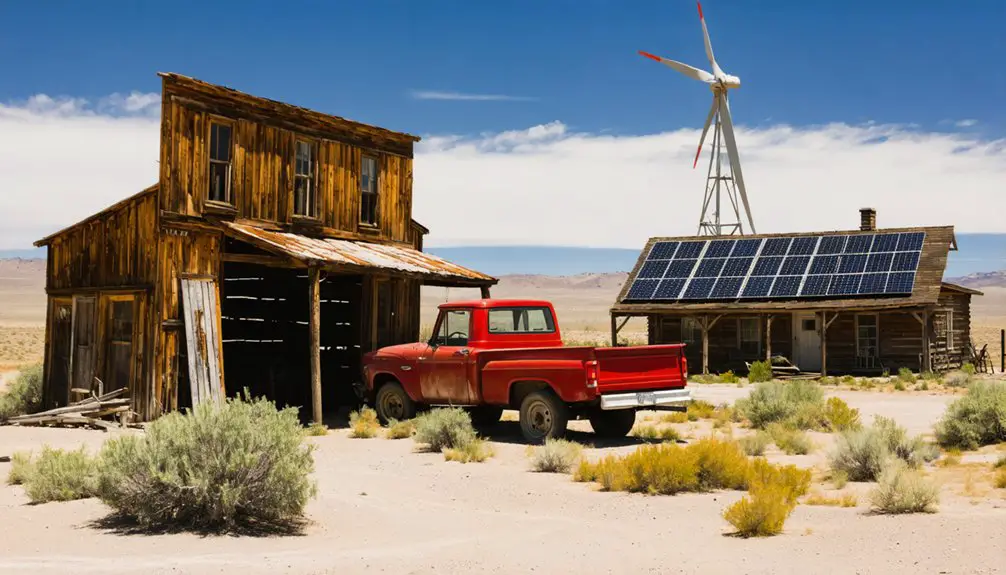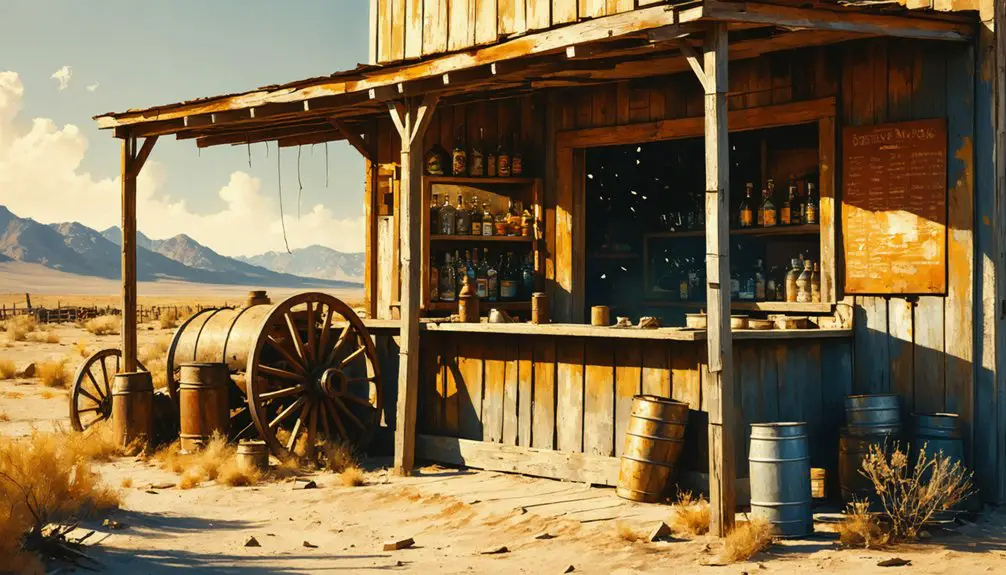You’ll find Fish Lake Valley nestled in western Nevada’s high desert, where the historic community of Dyer (est. 1881) serves as your gateway to the region’s mining past. The valley’s crown jewel was the Red Rock Mine, Nevada’s largest mercury producer by the 1930s. Today, you can explore preserved buildings at the Fish Lake Valley Heritage Center & Museum, which showcases authentic structures from the 1870s-1940s arranged in a distinctive semicircle. The valley’s rich history unfolds across its endorheic basin and sagebrush plains.
Key Takeaways
- Fish Lake Valley features several ghost town sites connected to the 1860s mining boom, centered around the Palmetto Mining District established in 1866.
- The Red Rock Mine, Nevada’s largest mercury producer in the 1930s, remains a preserved ghost town site with intact structures.
- Historic buildings at the Heritage Center include an 1870s cowboy cabin and structures salvaged from the region’s mining era.
- Self-guided ghost town tours showcase abandoned mining facilities, including preserved water towers, ore bins, and miners’ living quarters.
- The Fish Lake Valley Heritage Center & Museum displays mining artifacts and maintains historic buildings arranged in a semicircle for tourists.
The Valley’s Natural Landscape
Four distinct geographical features define Fish Lake Valley, a 25-mile endorheic basin in southwest Nevada that’s nestled between the White Mountains and Silver Peak Range.
You’ll find sprawling sagebrush plains stretching across the valley floor, leading to stark alkali flats where a 10-mile salt pan meets a central dry lake. Along the western edge, alluvial fans cascade from the White Mountains, carved by persistent mountain streams that feed the valley’s unique ecosystems.
The most striking natural habitat lies at Fish Lake Valley Hot Springs, where geothermal waters create an oasis amid the desert terrain. Cottonwood Creek waters sustain the valley’s natural springs and contribute to its seasonal wetlands.
Here, you’ll discover thriving natural habitats supporting diverse wildlife, from antelope herds in the foothills to specialized plant communities that have adapted to the valley’s saline soils. The valley’s pristine environment draws visitors seeking mountain biking trails and outdoor recreation opportunities.
Indigenous Roots and Early Settlement
Long before European exploration reached Fish Lake Valley, indigenous peoples made this fertile basin their seasonal home, with archaeological evidence revealing centuries of occupation by ancestors of the Paiute and Ute tribes, including the Fremont culture.
You’ll find that these native peoples embraced the valley’s natural abundance, establishing it as a crucial summer retreat where they’d hunt, fish, and perform ceremonies. The indigenous traditions centered around harvesting local plants like chokecherry, wild raspberry, and buffalo berry, which women processed into cakes and soups. These groups used earthen ovens to prepare their meals, carefully layering food between hot stones and grass for overnight cooking.
The cultural significance of Fish Lake Valley extended across various Ute bands, including the Mouache, Caputa, and Weenuchiu, who shared these lands through intermarriage and migration. This rich indigenous heritage continued until Spanish explorers arrived in the 1770s, followed by American trappers in the 1830s. Recent archaeological excavations led by BYU researchers uncovered evidence of multiple occupations over 2,000 years, including artifacts that demonstrate the area’s longstanding importance to Native peoples.
Mining Boom and Economic Growth
While indigenous peoples had long inhabited Fish Lake Valley, the area’s economic evolution began in the 1860s when prospectors discovered valuable mineral deposits, leading to the establishment of the Palmetto Mining District in 1866. The area’s rich history began when early pioneers first entered the valley in the 1830s.
The valley’s mining techniques evolved from early borax extraction to mercury mining, with the Red Rock mine becoming Nevada’s largest mercury producer by the 1930s. The mine was further enhanced when Walter Dunnigan constructed The Jig sluice box to improve profitability.
Key developments that shaped the valley’s economic sustainability:
- Production of 1,000 mercury flasks between 1928-1931 at the Red Rock mine
- Shift from underground tunnels to open pit mining to reduce operational costs
- Integration of mining with ranching activities to create a diversified economy
The mining boom brought infrastructure improvements, including stage lines and a post office, while supporting communities grew around the extraction sites.
The Birth of Dyer Community
When you explore Dyer’s origins in Fish Lake Valley, you’ll find its establishment firmly rooted in the 1881 creation of a post office under postmaster Alex P. Dyer, for whom the community was named.
The post office’s founding marked Dyer’s emergence as the valley’s central hub, serving the needs of local ranchers and residents who’d settled there since 1866.
The Fish Lake Valley post office later merged with Dyer’s location around 1960, further cementing the community’s role as the valley’s primary settlement.
Prior to Euro-American settlement, the area was home to indigenous Paiute and Shoshone peoples who lived off the fertile valley lands.
The valley’s strategic location and water resources from the White Mountains made it an ideal stop for the Carson and Columbus Stage Line connecting it to larger settlements.
Early Postal History
As the Fish Lake Valley community emerged in the late 19th century, the establishment of its first post office in 1881 marked a significant moment in the region’s development. The area’s growth was supported by Borax extraction operations that began in the 1870s.
The Carson and Columbus Stage Line transported mail and passengers through the valley, making postal services vital for the growing community. The post office’s significance extended beyond mail delivery, becoming an essential hub for the frontier settlement’s communication networks. Named after its first postmaster, Alex P. Dyer, the facility played an important role in connecting the remote valley to regional transport routes and stage lines.
- Seven post offices operated throughout Dyer’s history, reflecting the area’s dynamic population shifts.
- The post office supported economic growth by facilitating reliable mail exchanges for mining and ranching operations.
- Today, you’ll find portions of the original post office preserved at the Fish Lake Valley Heritage Center & Museum.
Settlement and Growth
Before American settlers arrived in Fish Lake Valley, the Paiute and Shoshone peoples thrived in this resource-rich region, sustainably harvesting fish and game from its abundant streams and springs.
The valley’s settlement patterns shifted dramatically after the establishment of the Palmetto Mining District in 1866, when borax extraction drew the first wave of Euro-American settlers.
The community’s development accelerated as ranching and agriculture took root, with pioneers establishing homesteads to supply nearby mining camps.
You’ll find that the town of Dyer emerged as the valley’s hub, named after Postmaster Alex P. Dyer when the post office opened in 1881.
Today, you can explore this heritage at the Fish Lake Valley Heritage Center & Museum, where Linda Williams has preserved the authentic artifacts of the region’s mining and ranching past.
Historic Buildings and Architecture

Through careful preservation efforts, Fish Lake Valley’s historic buildings showcase the architectural heritage of Nevada’s mining and ranching era.
The Heritage Center’s architectural restoration features timbers salvaged from the Mina railroad depot, while the historical significance of early 1920s structures like the Folwick Ranch gas station provides glimpses into the region’s past.
You’ll discover these fascinating features throughout the site:
- Original 1905 mountain cabins with authentic redwood flooring and screen doors
- Hand-hewn timber craftsmanship displaying period-appropriate construction methods
- The 1881 post office building, preserved as a representation of frontier communication
The wooden structures, featuring covered porches and traditional Western design elements, represent typical frontier architecture.
You’ll find these buildings thoughtfully arranged in a semicircle, allowing you to experience the authentic charm of this historic mining and ranching community.
Preserving Local Heritage
When local resident Linda Williams established the Fish Lake Valley Heritage Center & Museum, she launched a community-wide effort to preserve the area’s vanishing history.
Through community initiatives, the museum became a hub for collecting historic artifacts, relocating endangered buildings, and documenting stories from pioneer descendants through Heritage Reunion gatherings.
The center’s heritage education programs emphasize hands-on learning experiences, making it a popular destination for student field trips.
You’ll find interactive exhibits showcasing mining camp life cycles, ranching operations, and pioneer family histories.
The museum grounds feature authentically restored structures, including a historic post office, bunkhouse, and mining camp house.
Salvaged materials from regional sources, like the Mina railroad depot, have been repurposed to maintain architectural authenticity while preserving the area’s industrial and agricultural legacy.
Ghost Town Tourism Today

When you visit Fish Lake Valley’s abandoned mining sites today, you’ll find a collection of weathered structures that tell the story of Nevada’s boom-and-bust mining era.
The historical buildings that remain standing include remnants of ore processing facilities and scattered miners’ accommodations, though many are now in various states of decay.
You can explore these authentic ruins through self-guided tours, but exercise caution as the structures are unstable and require respectful distance for both safety and preservation.
Exploring Abandoned Mining Sites
Since the decline of mining operations, Fish Lake Valley‘s abandoned sites have become popular destinations for ghost town enthusiasts seeking authentic glimpses into Nevada’s mining heritage.
You’ll discover abandoned artifacts scattered throughout the area, including ore bins, water towers, and unique rock cabins that once housed mining employees. Mining relics and industrial remnants tell the story of the valley’s mercury mining heyday.
When exploring these historic sites, you’ll want to:
- Visit the Red Rock Mine to see its preserved water tower, ore bin, and rotary furnace
- Check out the Heritage Center & Museum in Dyer for mining artifacts and historic displays
- Explore the various workshops, outbuildings, and abandoned vehicles while following posted safety warnings
Historical Buildings Still Standing
The Fish Lake Valley Heritage Center stands as a remarkable tribute to the area’s rich history, featuring a thoughtful arrangement of historical buildings in a semicircle near Dyer, Nevada.
You’ll discover ghost town architecture spanning nearly a century, from an 1870s cowboy cabin to a 1947 Westwood travel trailer. Each structure tells a unique story of the valley’s development, including the area’s first gas station and one of Dyer’s original post offices.
The historical preservation efforts, led by local residents, have saved these authentic pieces of the past.
You’ll find buildings constructed with timbers from the Mina railroad depot, along with exhibits displaying cooking tools, ranch machinery, and Native American artifacts.
These carefully restored structures create an immersive journey through Fish Lake Valley’s evolution from mining settlement to agricultural community.
Geological Wonders
Massive mountain ranges flank Fish Lake Valley, creating a classic example of Nevada’s Basin and Range topography.
You’ll discover remarkable geological formations shaped by ancient volcanic activity, with the Hot Creek Range to the east and Monitor Range plus Table Mountain to the west. The valley floor rests on thousands of feet of alluvium covering Paleozoic limestone, carved by north-trending faults.
Ancient volcanic forces carved Fish Lake Valley between Hot Creek and Monitor ranges, layering deep alluvium over limestone bedrock.
- Warm springs bubble up through alluvial deposits, revealing the valley’s hidden geothermal features
- Volcanic ash deposits from distant volcanic centers like Long Valley Caldera tell stories of explosive prehistoric events
- Eight ancient alpine glaciers left their mark through moraines and outwash deposits, sculpting the rugged landscape you see today
This untamed terrain also holds uranium-rich sediments across 675 acres of former lake and marsh beds.
Life in the Modern Valley

Beyond the stark geological features, modern life in Fish Lake Valley reflects Nevada’s least populous region, where approximately 720 residents carve out their existence across Esmeralda County‘s vast expanses.
You’ll find a community facing modern challenges head-on, with residents working primarily in mining, agriculture, and government sectors. Despite below-average incomes and limited job opportunities, community resilience shines through in the valley’s agricultural heart, where 20 farms manage over 27,000 acres.
You’re witnessing a lifestyle deeply connected to the land, with cattle ranching and alfalfa production dominating local agriculture. While federal control of 98% of the land restricts development, it guarantees open access for grazing, mining, and recreation – freedoms that locals fiercely protect while adapting to water scarcity and infrastructure limitations.
Frequently Asked Questions
What Happened to the Families Who Lived in Gold Point After 1962?
After Gold Point’s decline, you’d find families scattering to neighboring towns, seeking fresh starts. Some joined military service, while others relocated across states. Only the Wileys and a few caretakers remained behind.
Are There Any Remaining Artifacts From the Spanish Explorers in Fish Lake?
You won’t find confirmed Spanish artifacts in Fish Lake, despite explorer history in the region. While Spanish traders used nearby routes, no physical evidence remains of their brief passages through the area.
How Did Early Settlers Communicate With Neighboring Valleys Before Postal Service?
Though you might expect smoke signals, you’d mainly rely on verbal communication during seasonal gatherings, trade meetings, and face-to-face interactions with travelers who carried news between valleys along established trail networks.
What Native American Artifacts Have Been Found in Fish Lake Valley?
You’ll find evidence of native culture through petroglyphs, stone drills, fossilized fish, pottery, bone beads, and a grizzly bear tooth pendant. Archaeological significance extends back 9,000 years at Fish Cave.
Which Original Mining Claims Are Still Active in the Fish Lake Region?
Spanning 4,002 acres, you’ll find ACME Lithium’s 207 active claims, plus Lithium Corporation’s 11,360-acre holdings. They’re all on BLM land and focus on extracting lithium from claystone and brine deposits.
References
- https://travelnevada.com/cities/dyer/
- https://ridermagazine.com/2018/08/06/visiting-ghostly-towns-in-nevadas-esmeralda-county/
- https://nevadamagazine.com/issue/fall-2024/24578/
- https://travelnevada.com/museums/fish-lake-valley-heritage-center-and-museum/
- https://en.wikipedia.org/wiki/Fish_Lake_Valley
- http://www.fs.usda.gov/r04/fishlake/recreation/geologic-wonders
- https://thedyrt.com/camping/nevada/fish-lake-hot-springs
- https://data.nbmg.unr.edu/Public/Geothermal/SiteDescriptions/LittleFishLakeValley.pdf
- https://magazine.byu.edu/article/a-crossroads-of-cultures/
- https://www.southernute-nsn.gov/history/



